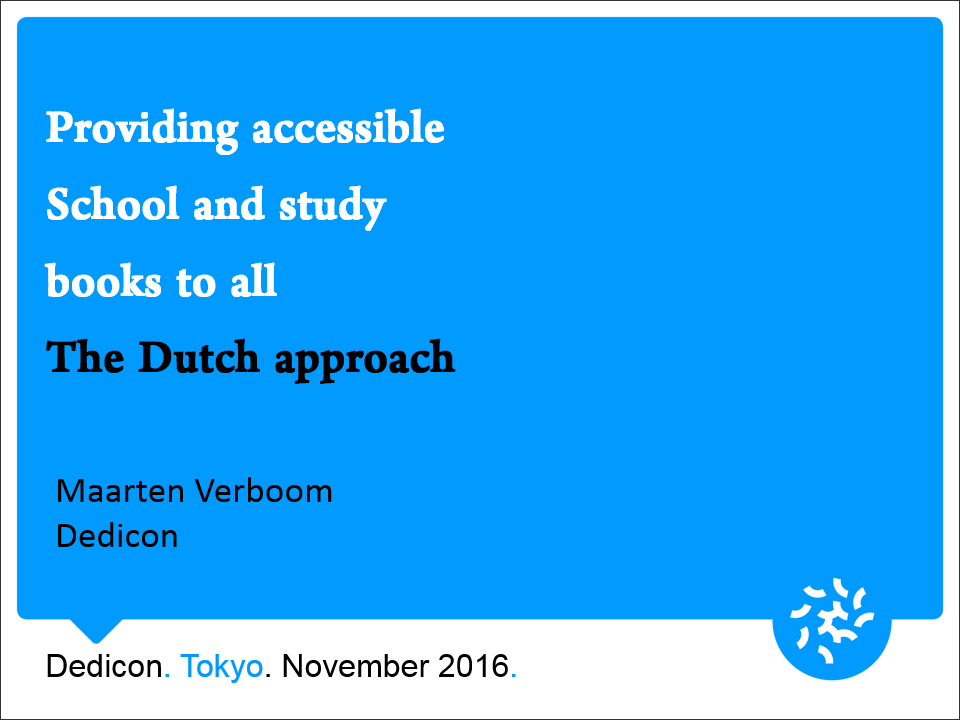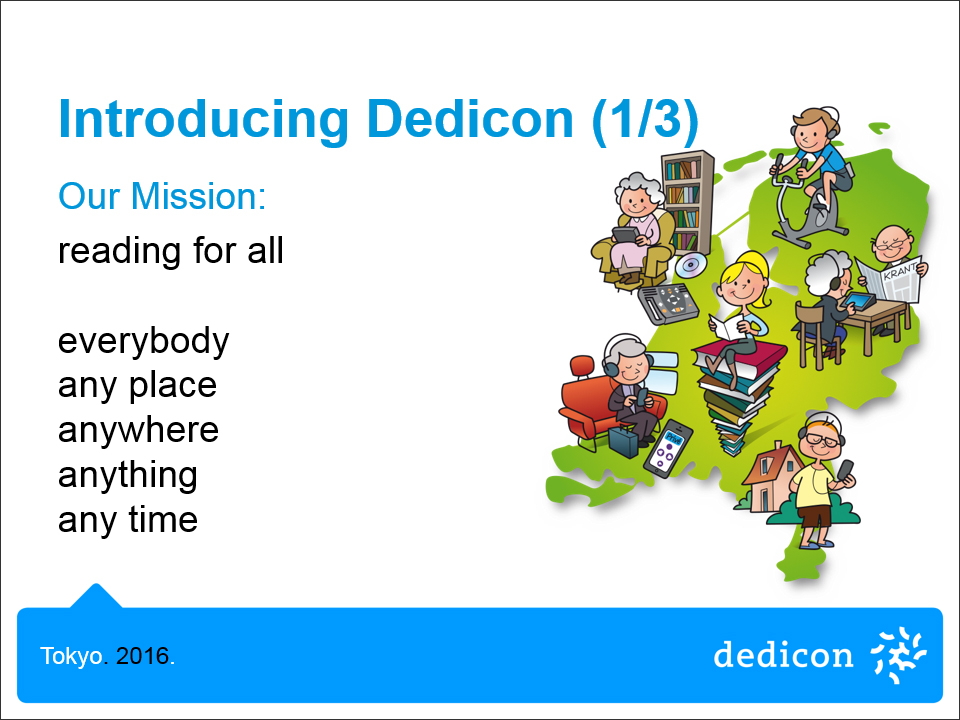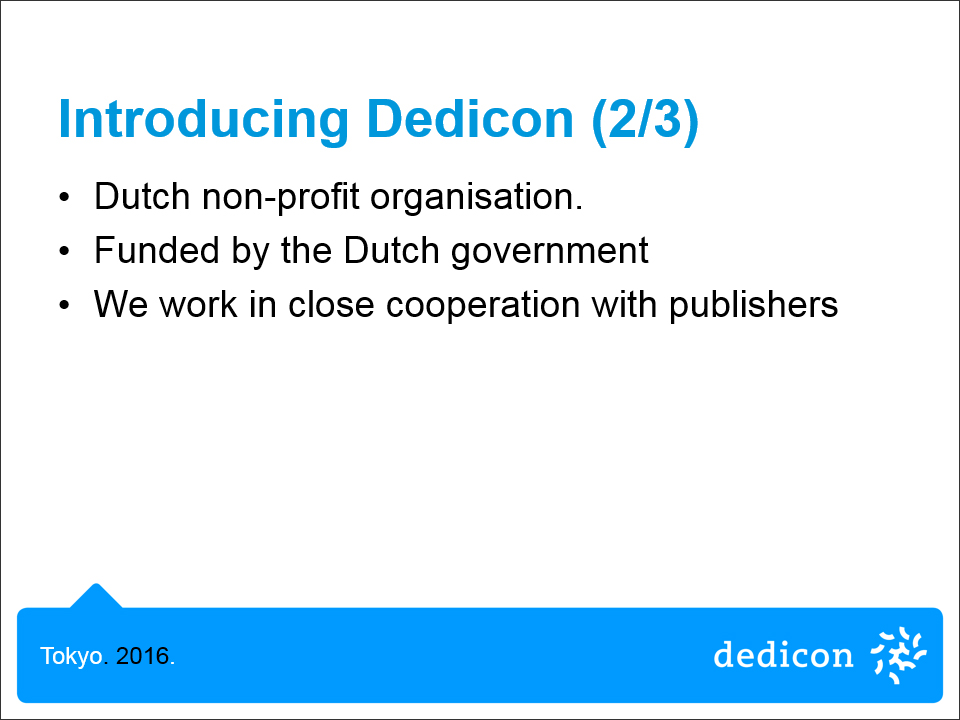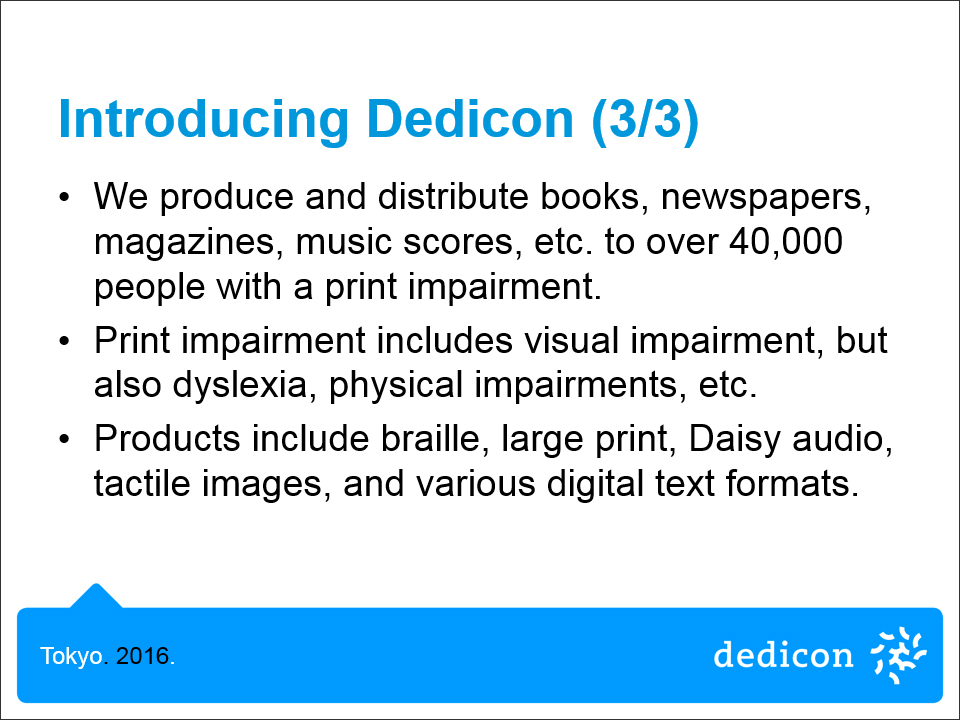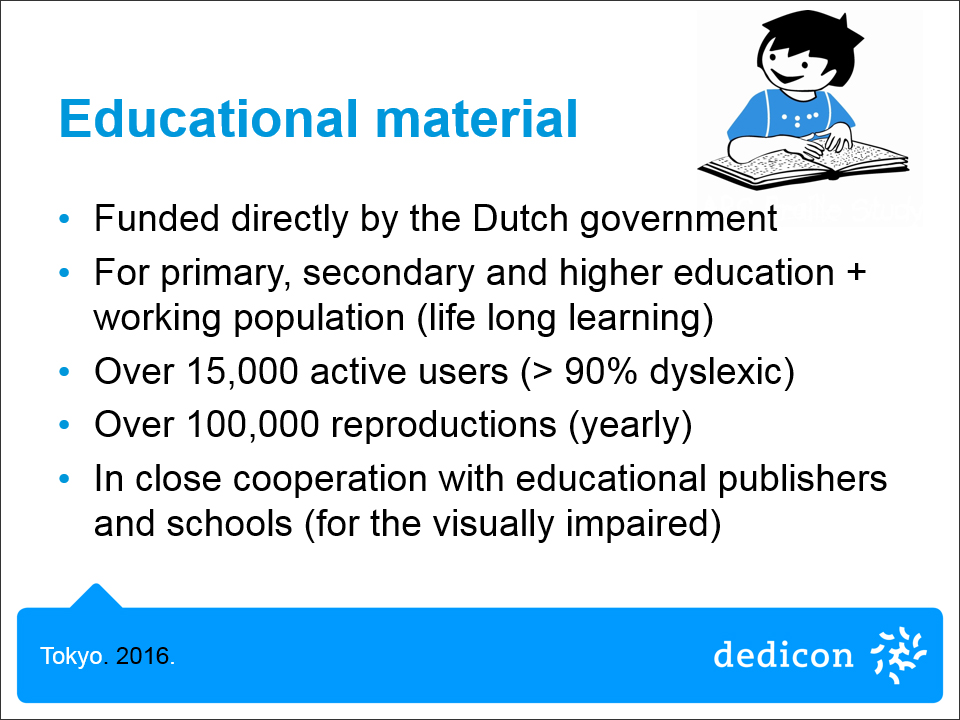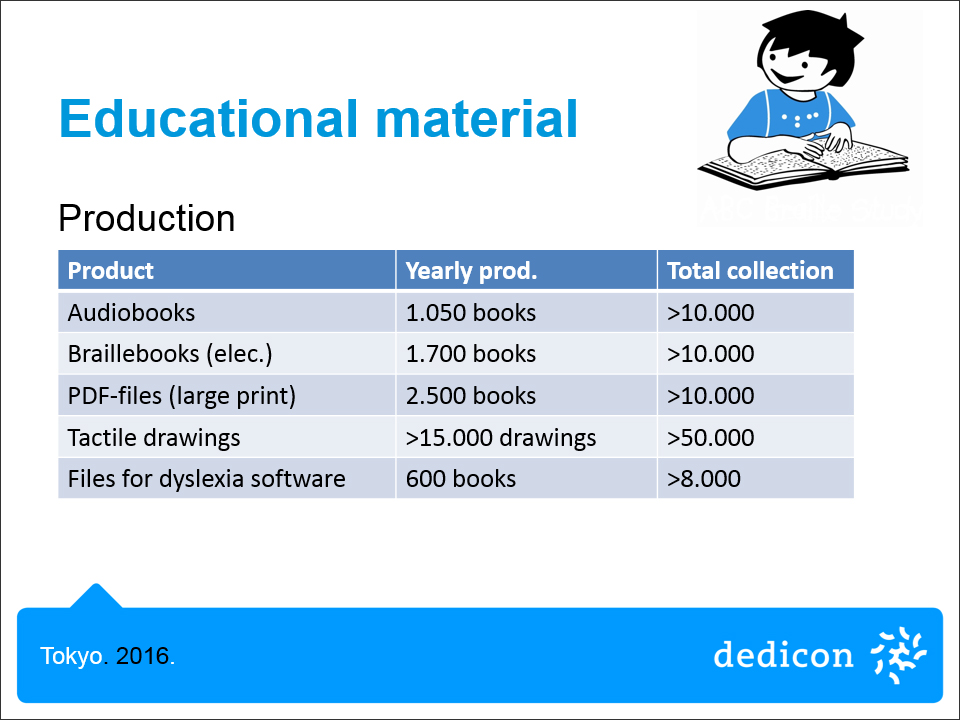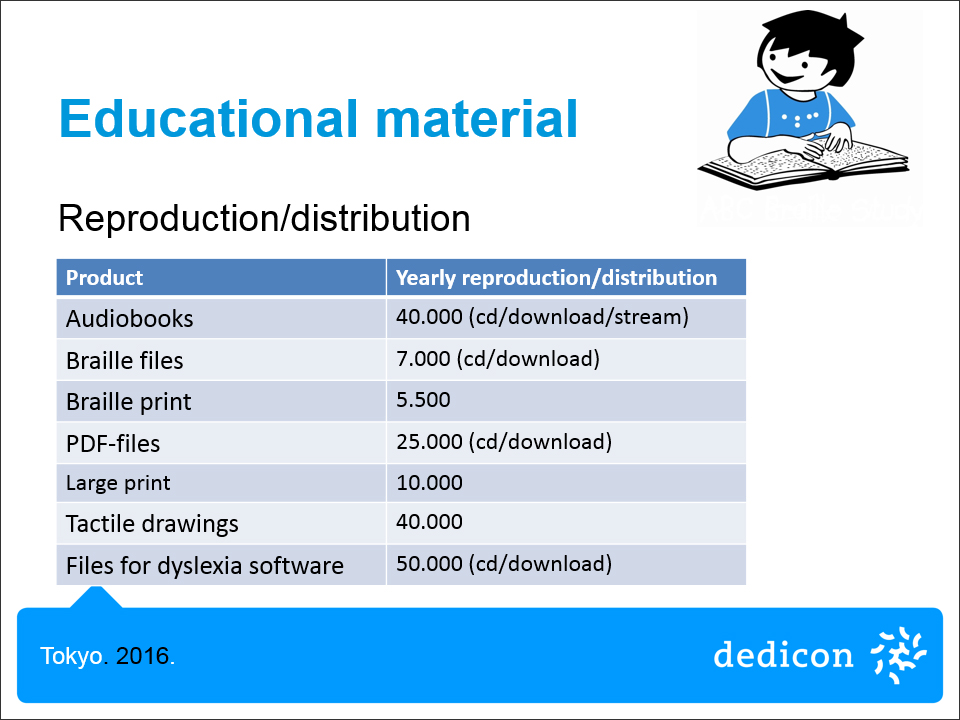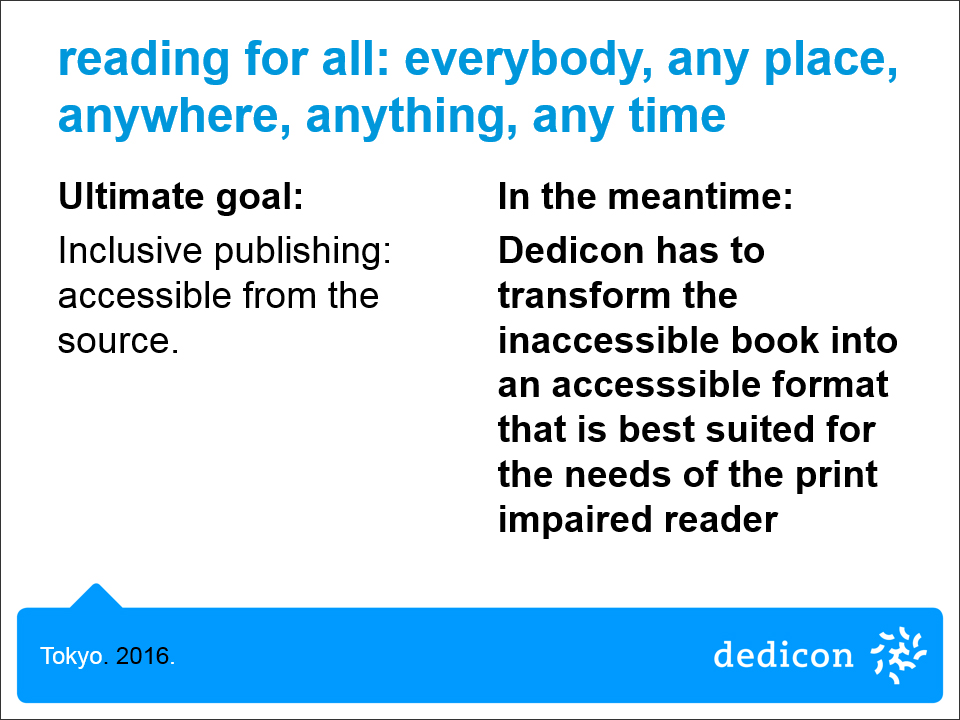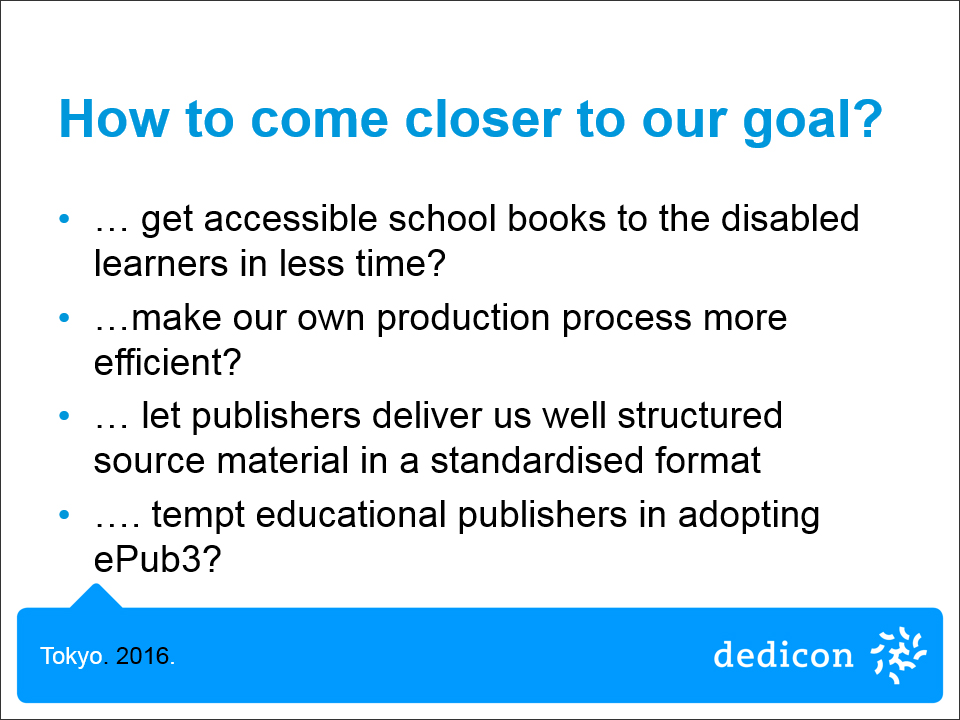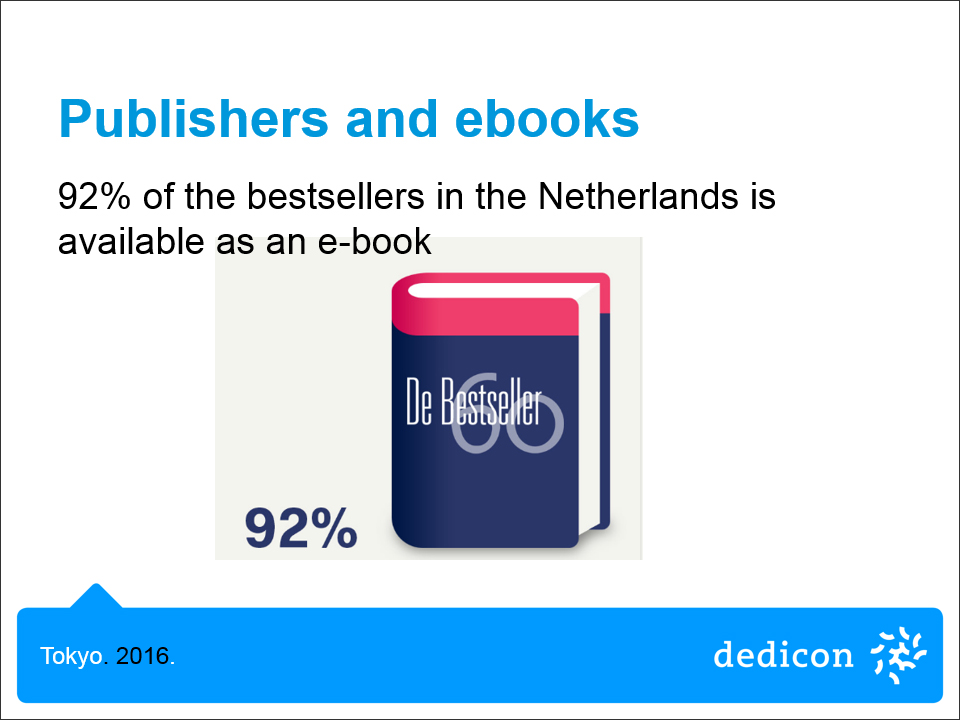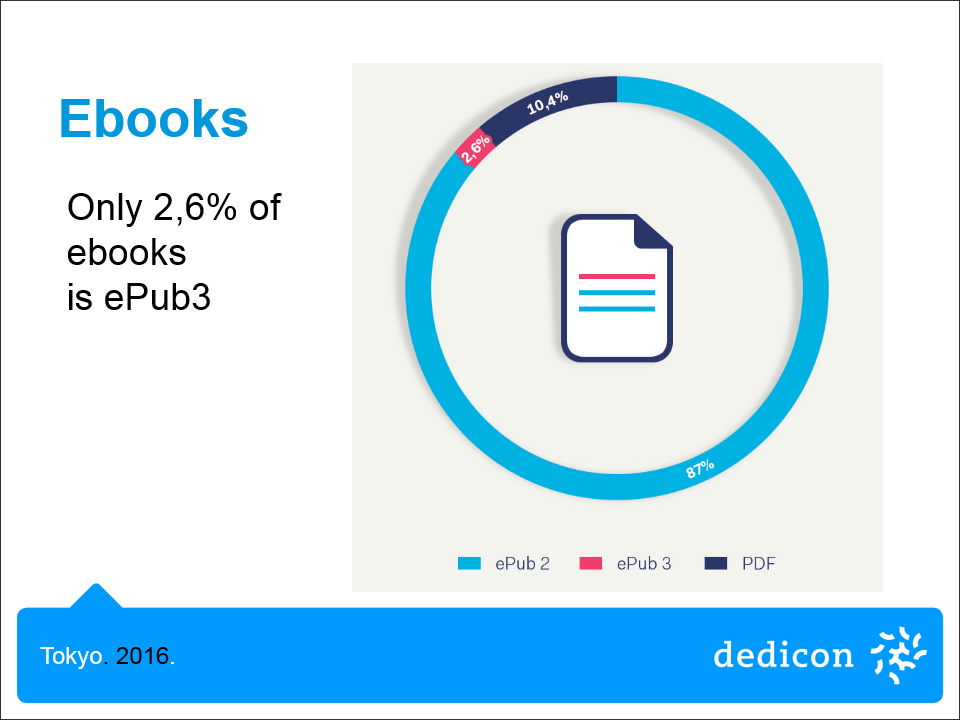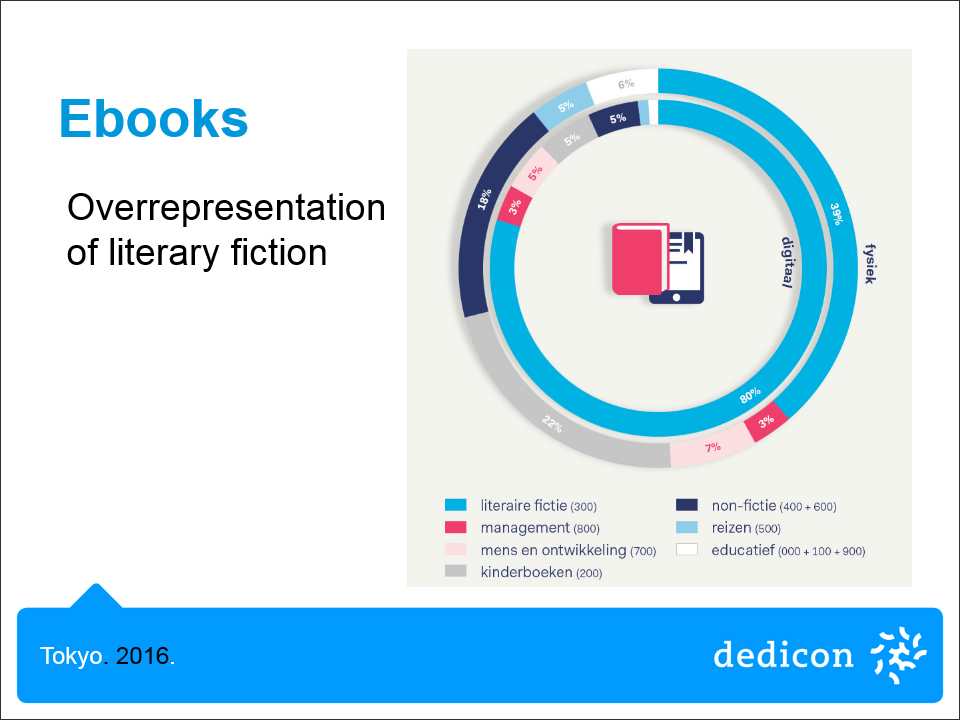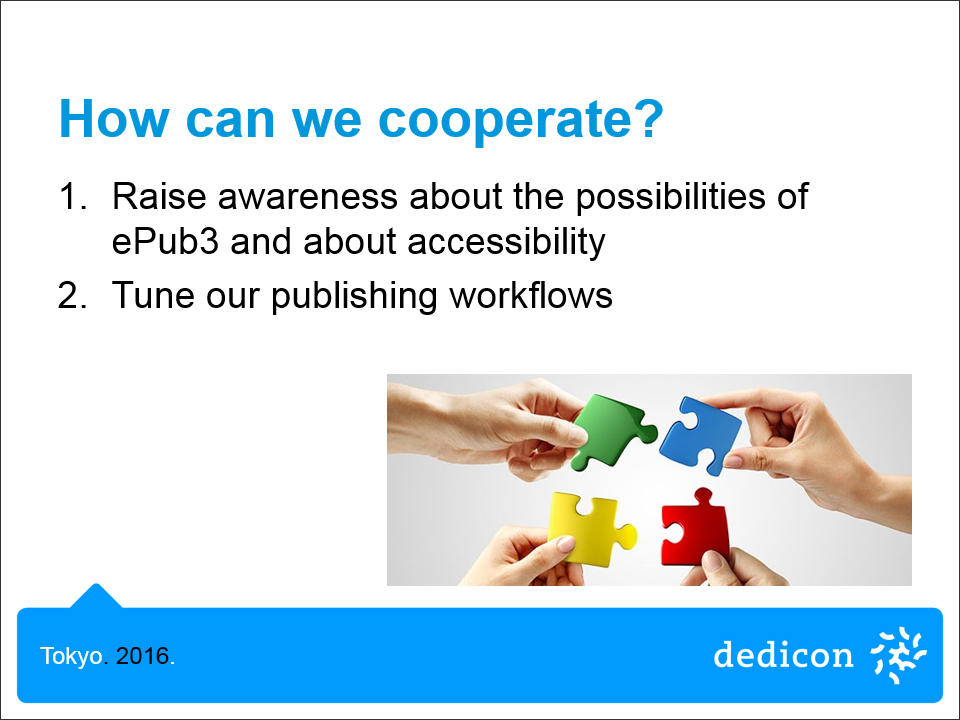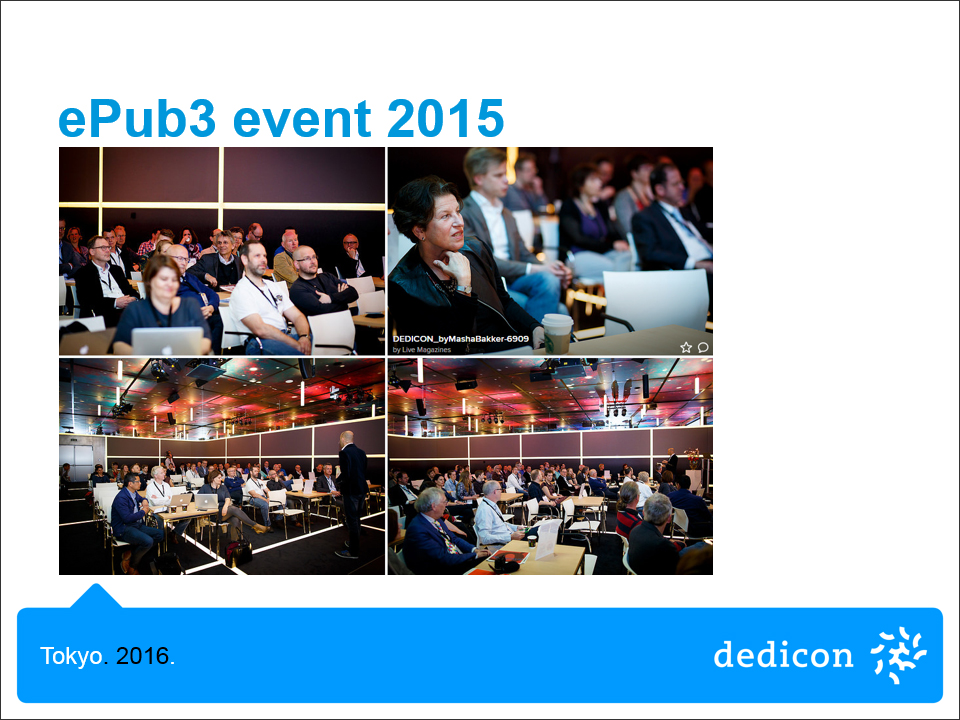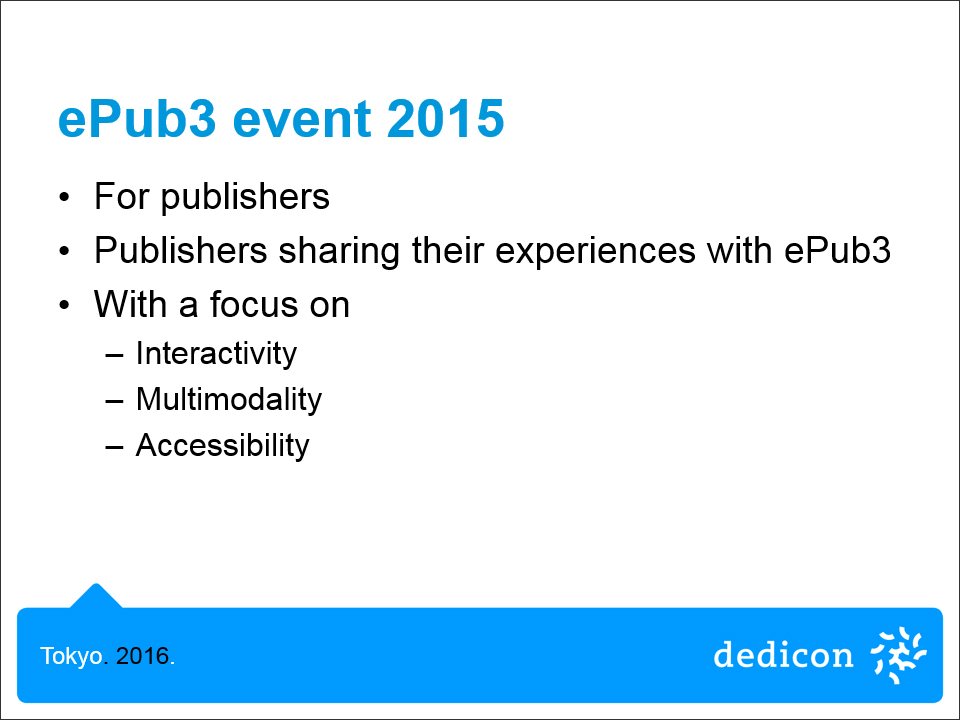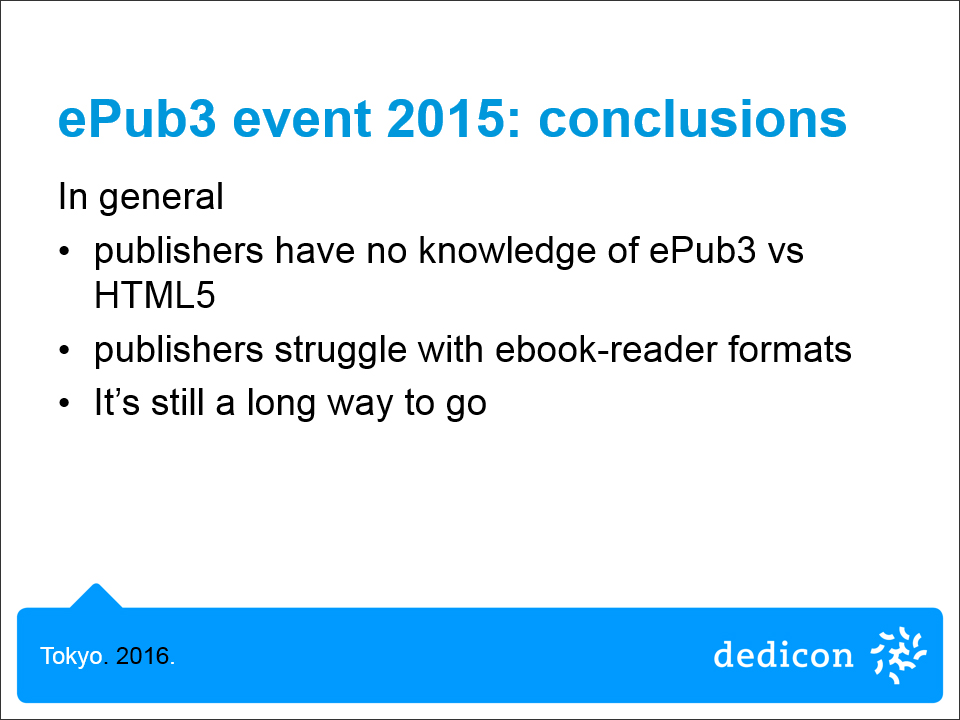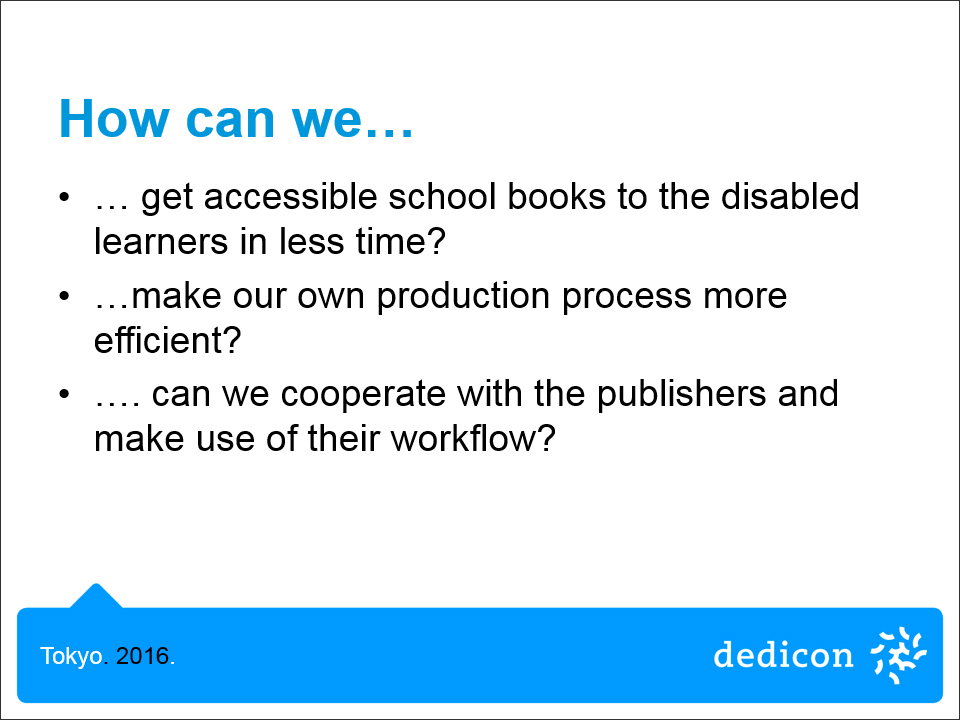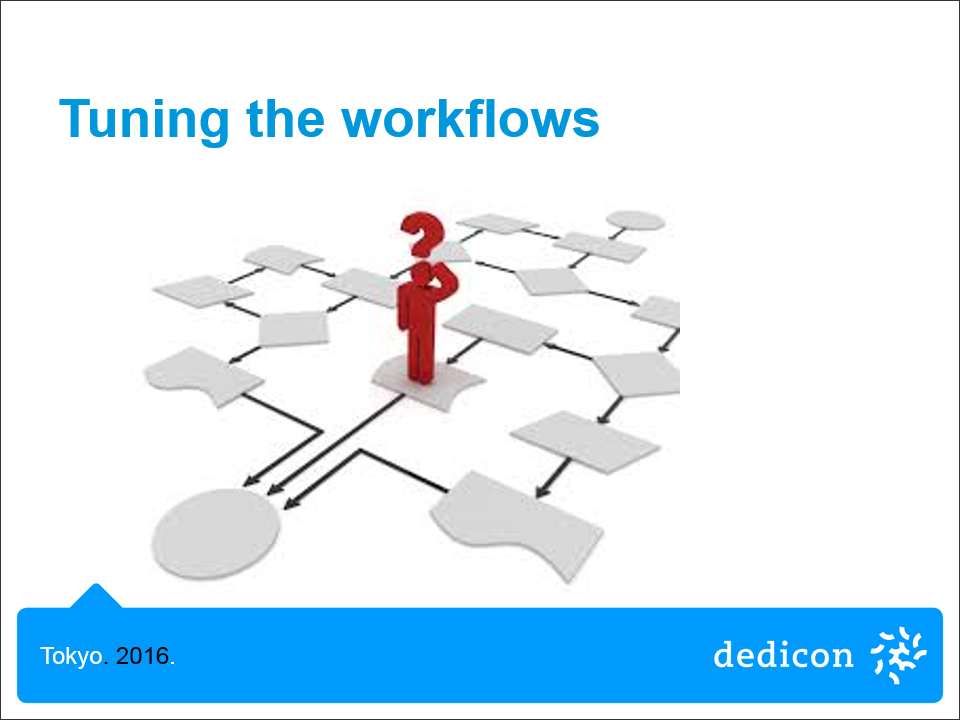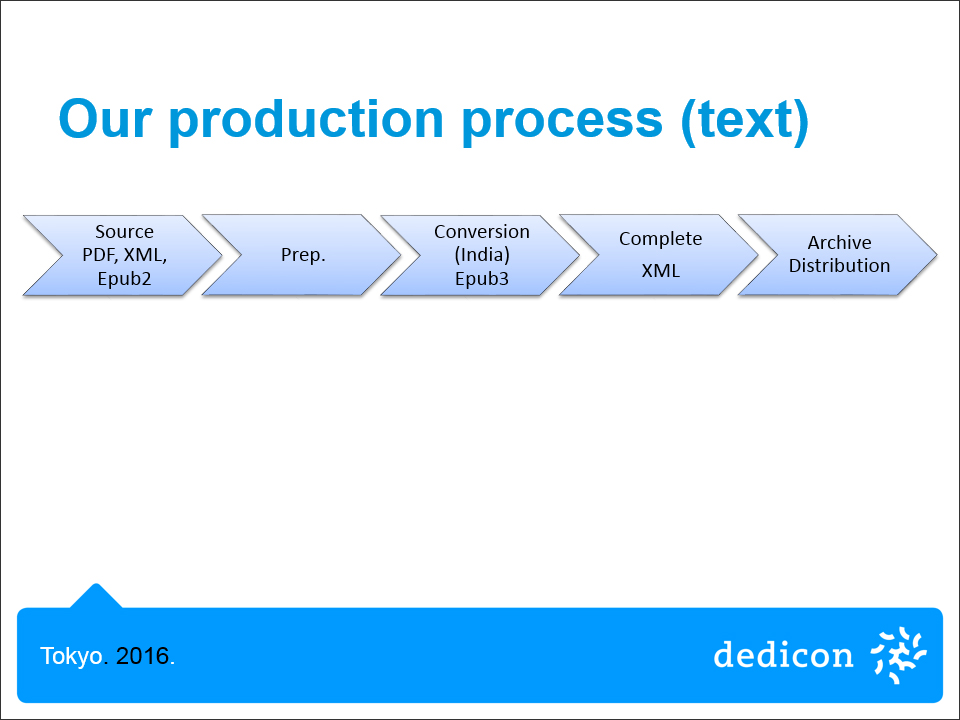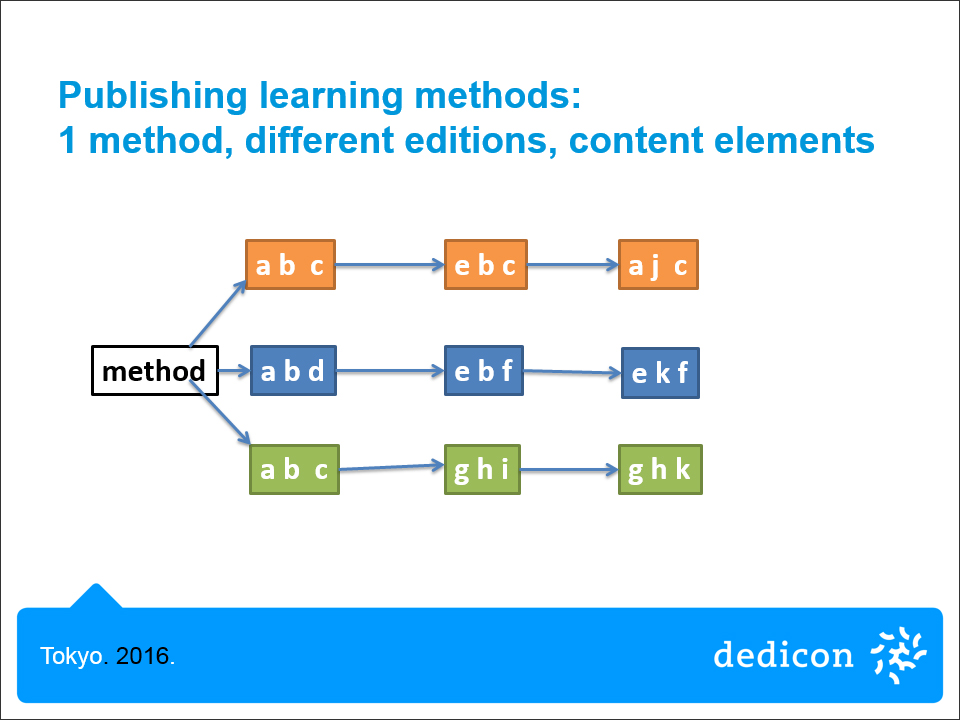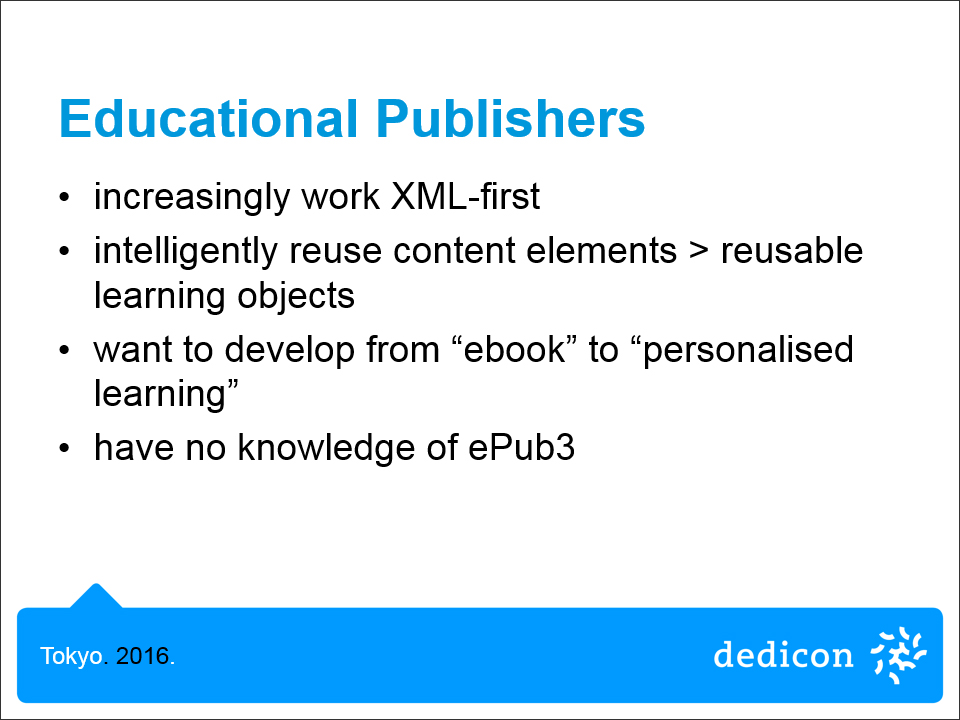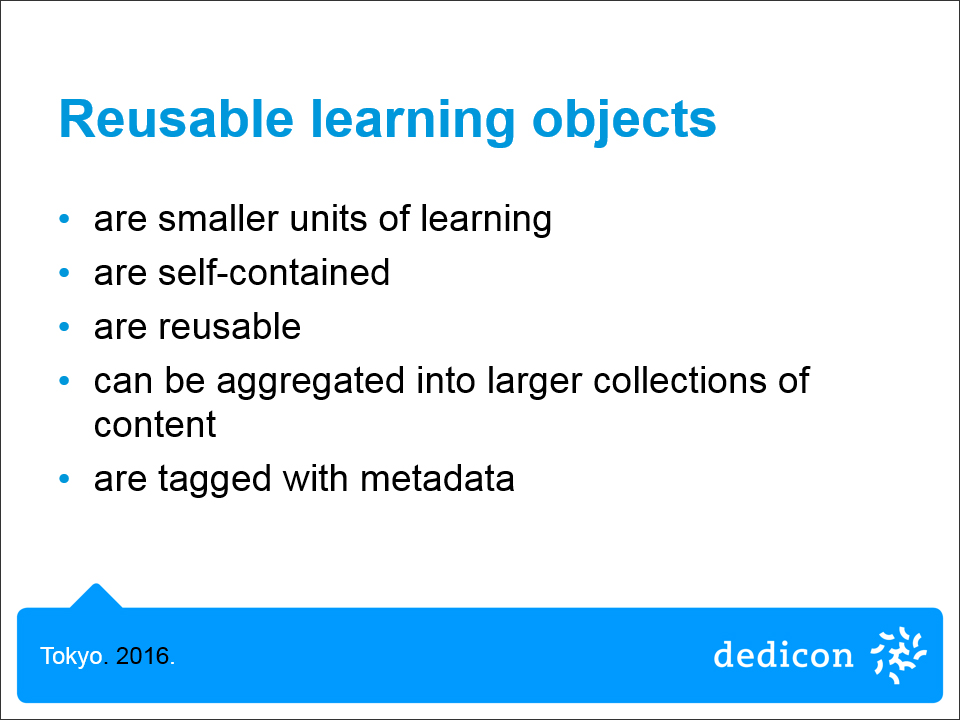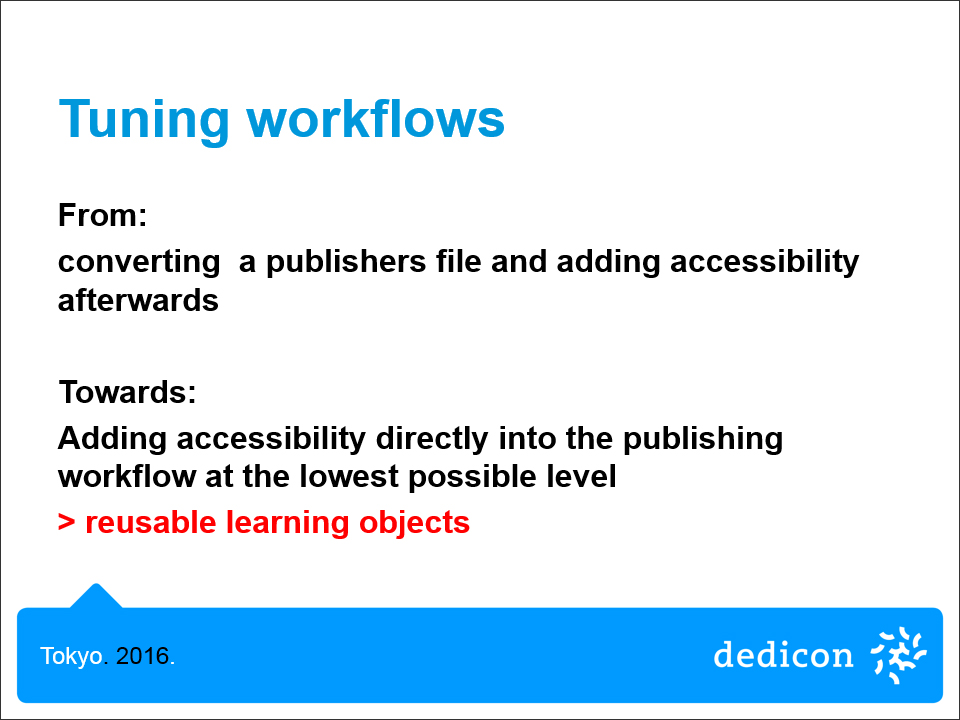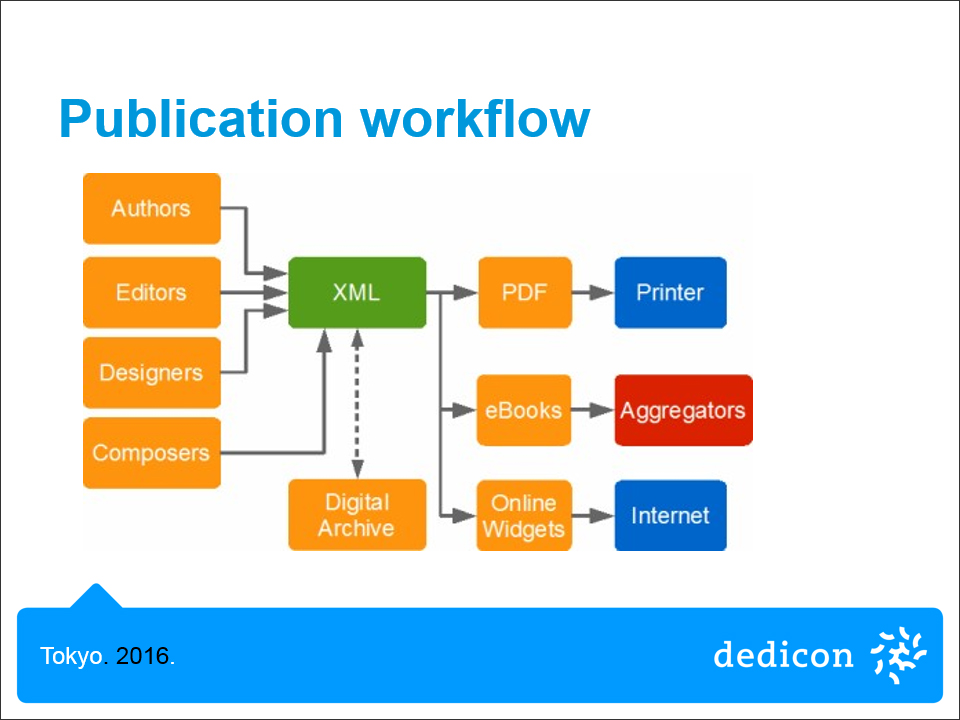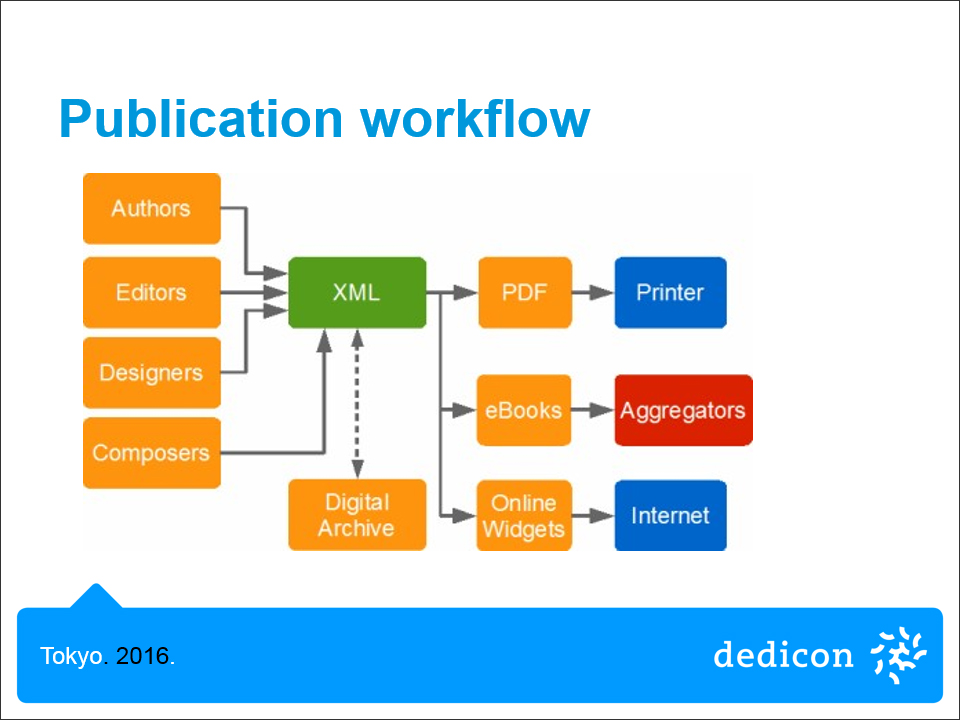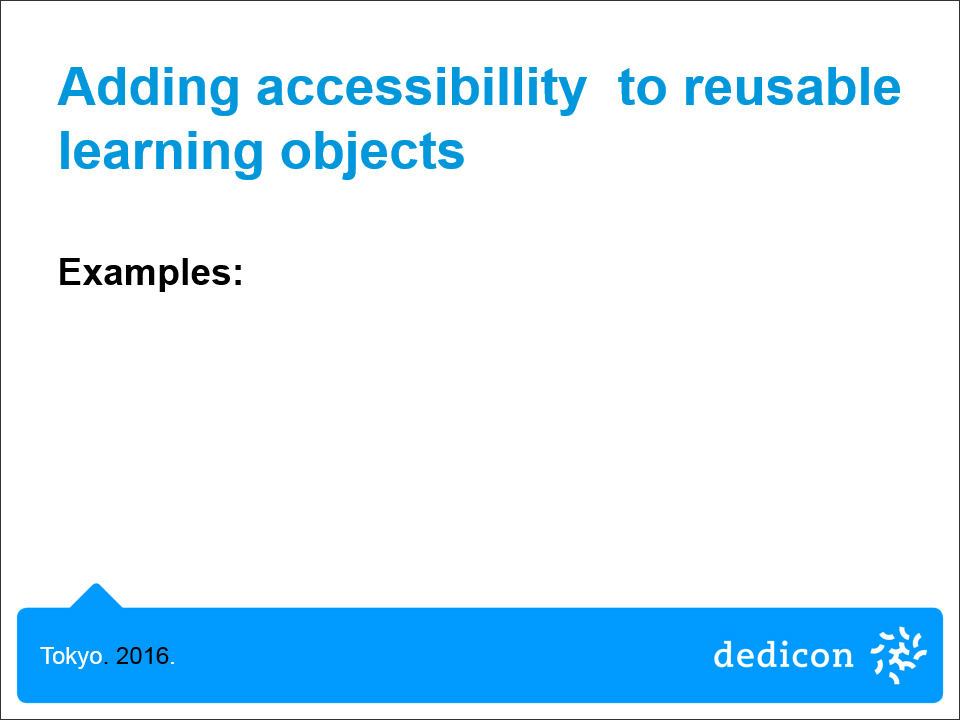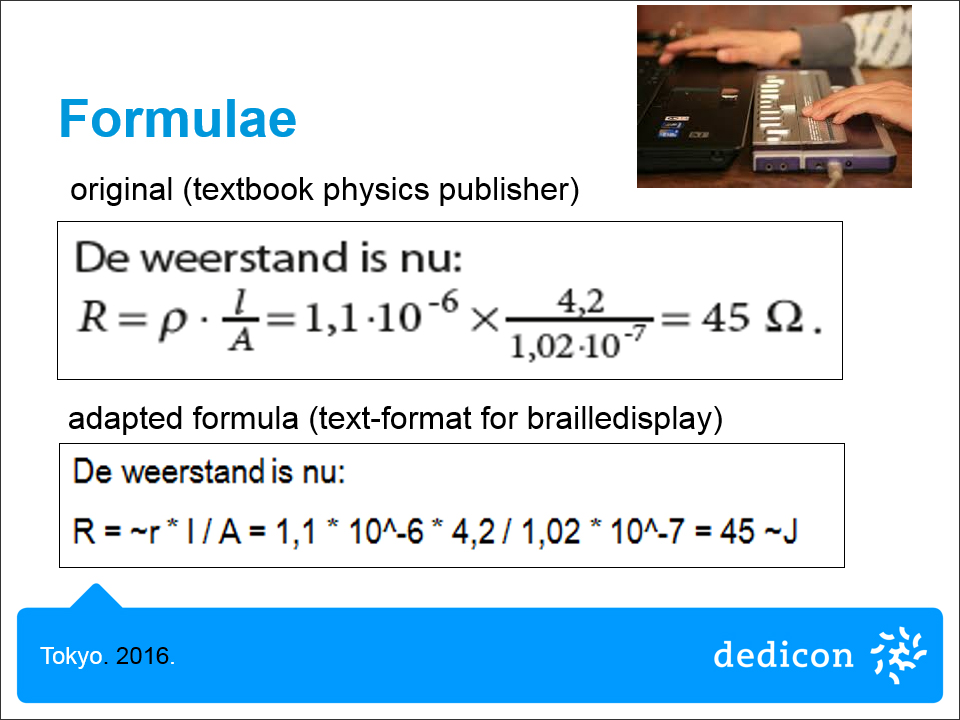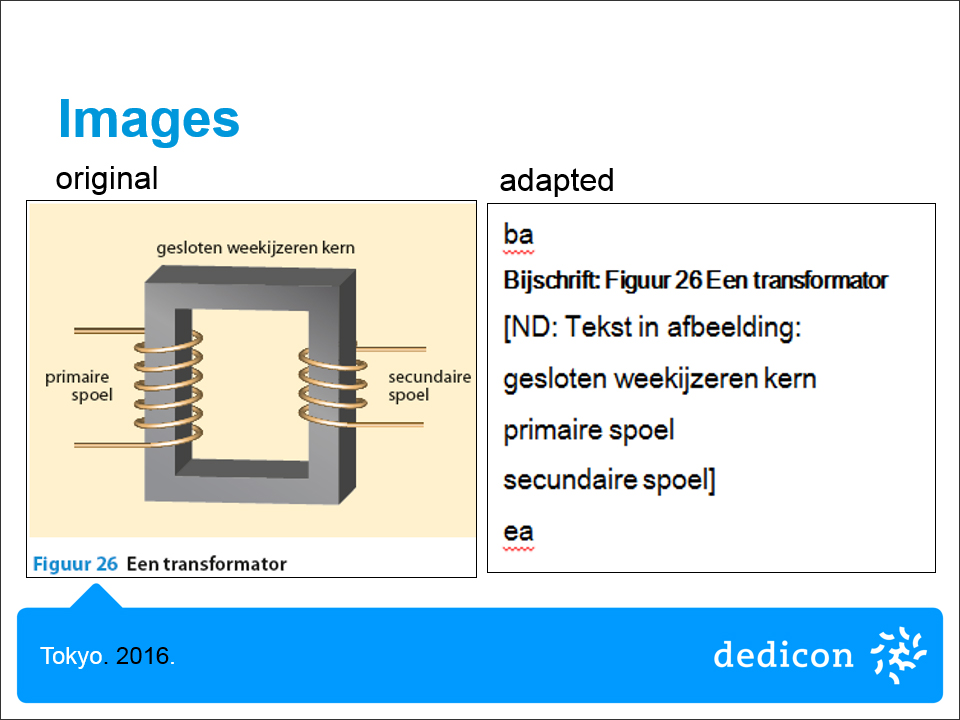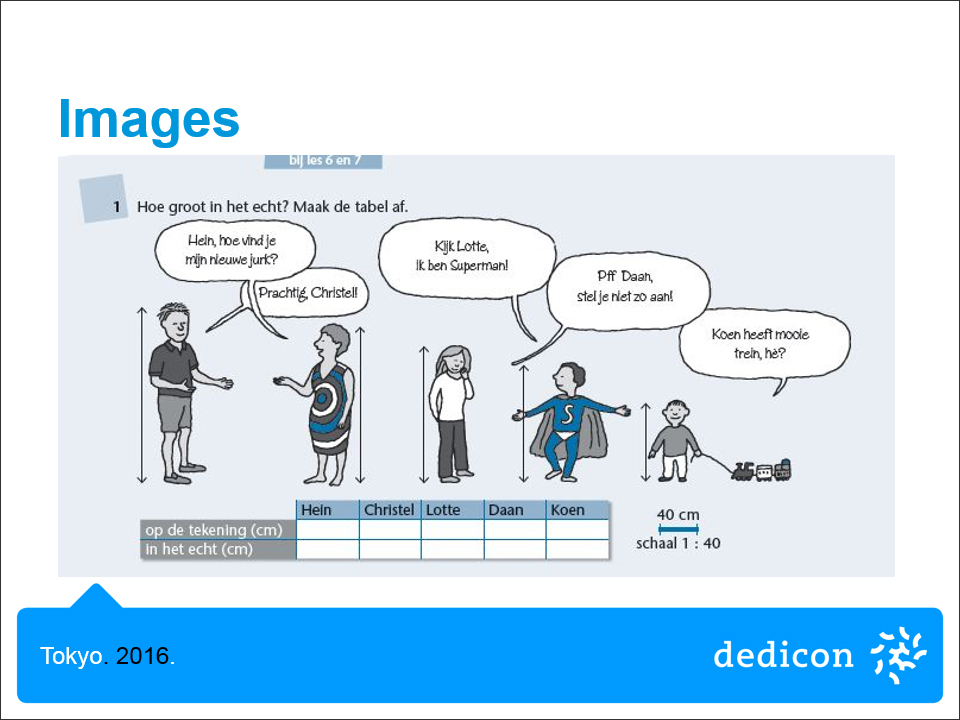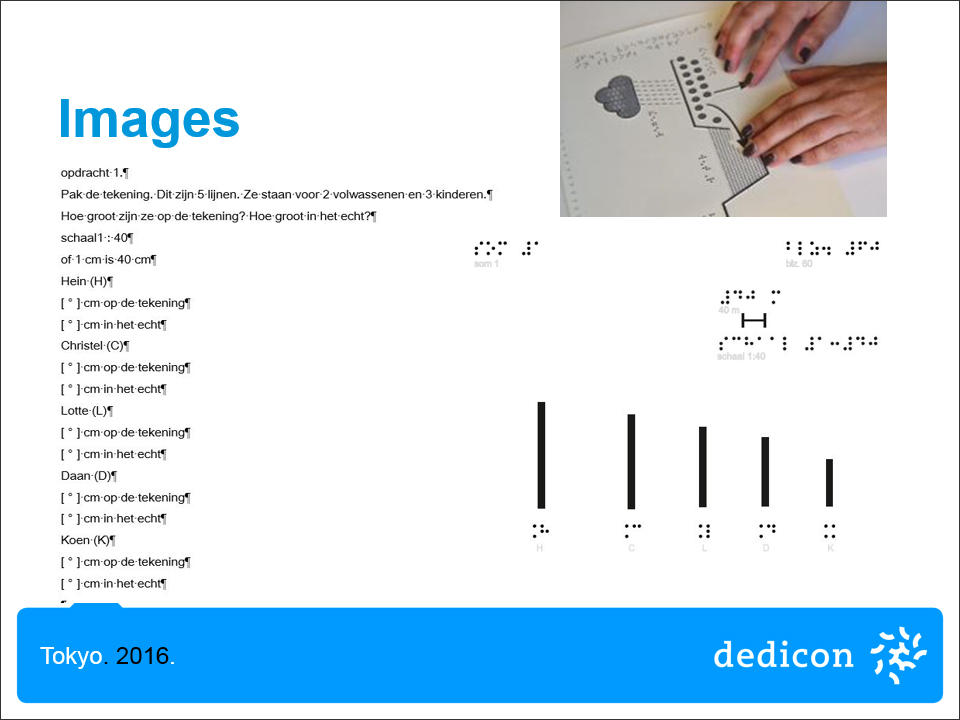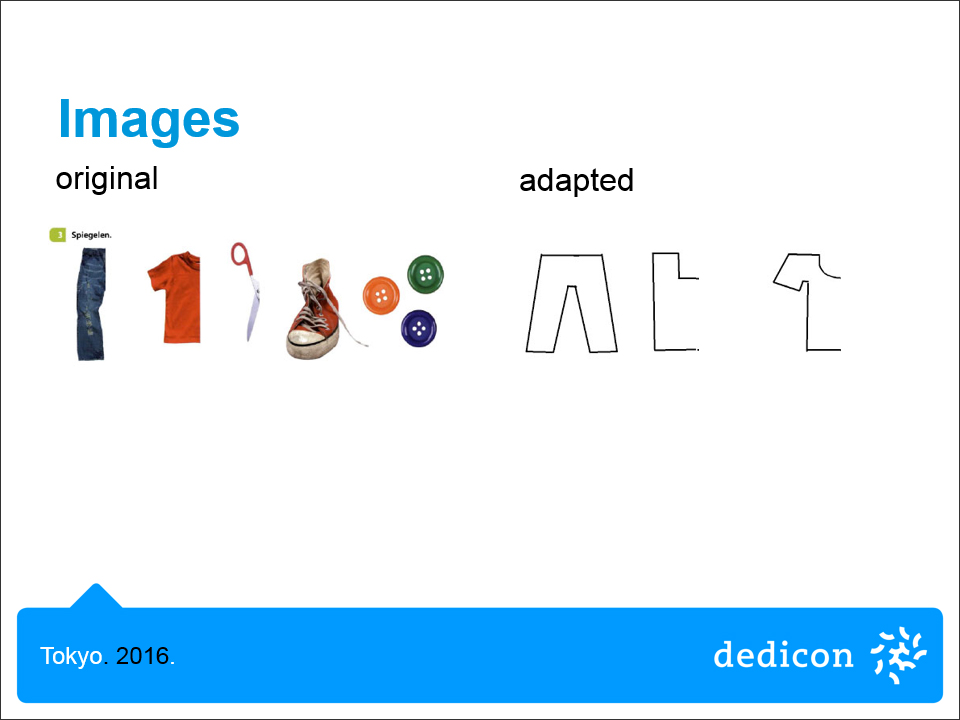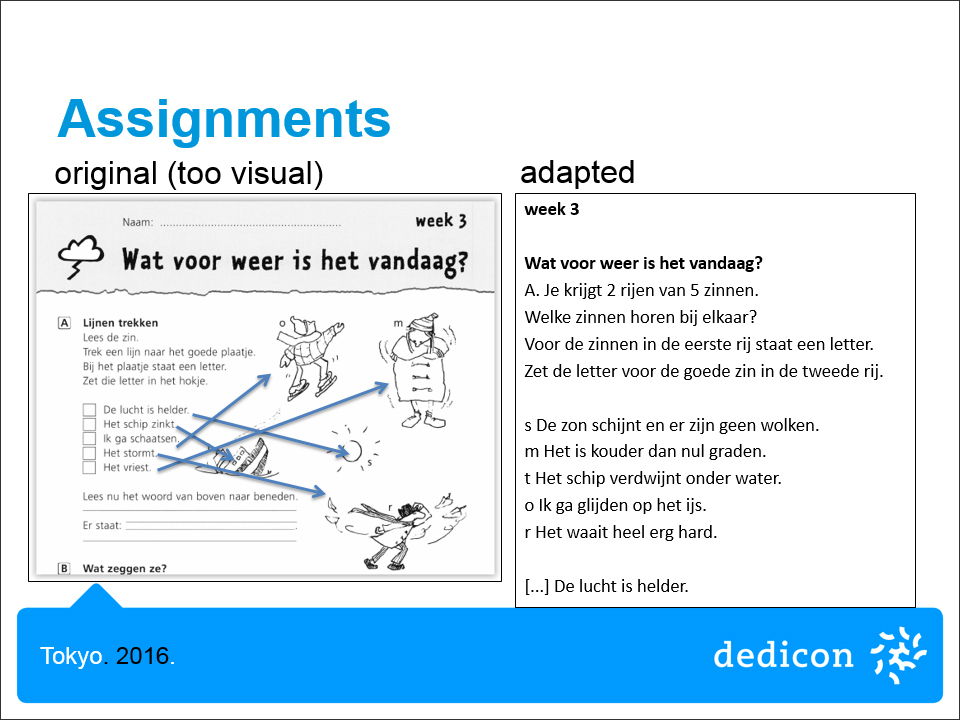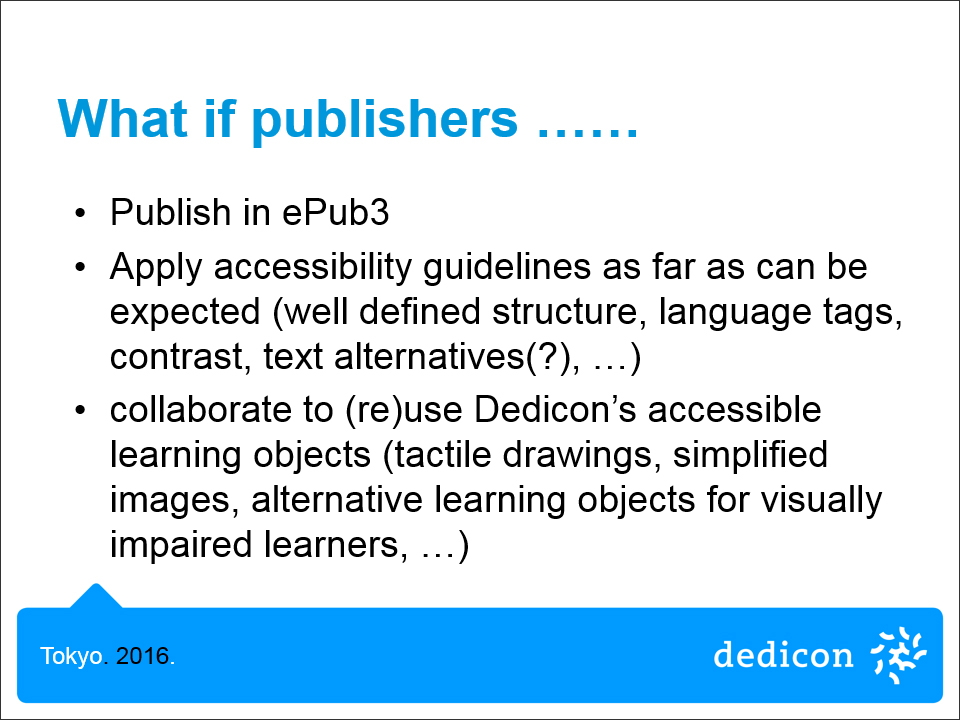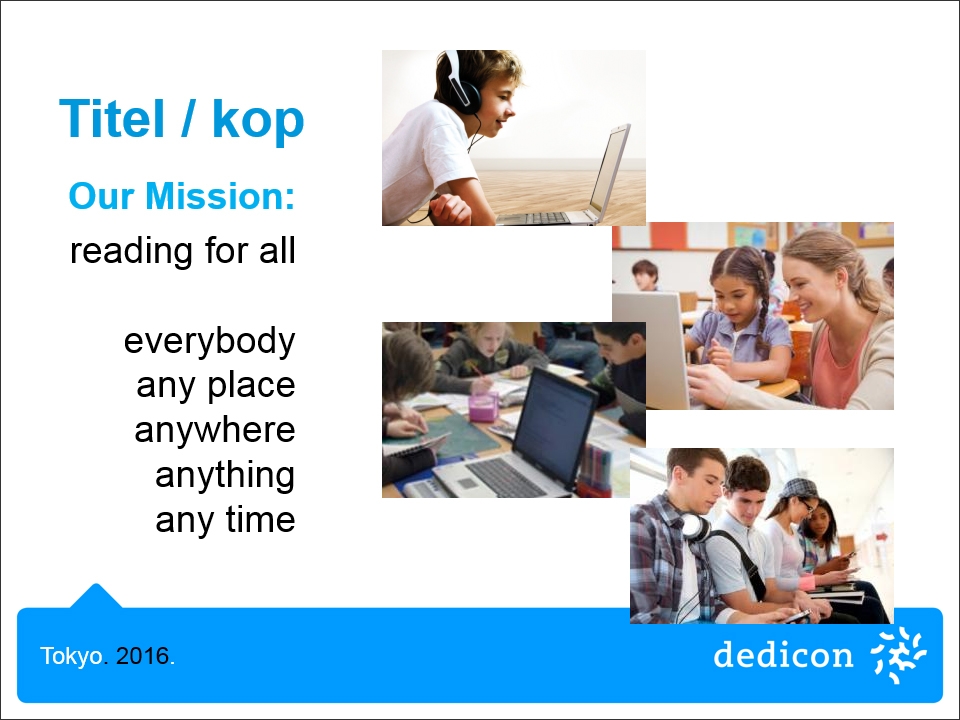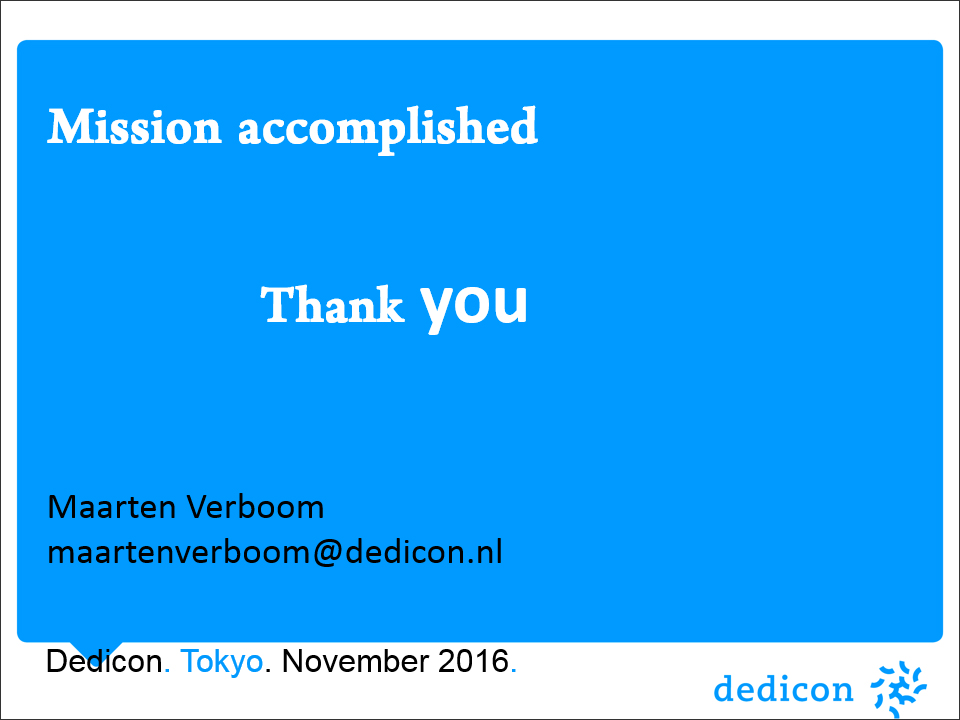Lecture 1: How to achieve "born accessibility" of digital textbooks - The Dutch model
Maarten Verboom
Chief Executive Officer, Dedicon
The Netherlands
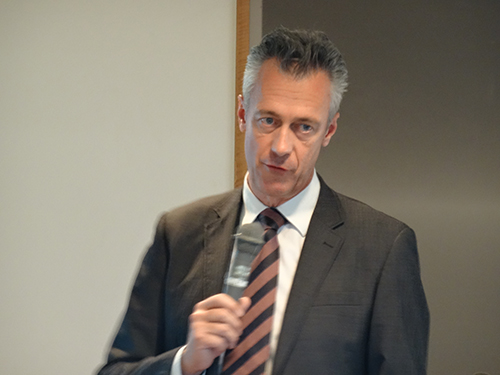
Thank you very much for this introduction. Good afternoon, ladies and gentlemen. It's for me a big honor to be in this place, to give a presentation to you. I want to thank the JSRPD, the Japanese DAISY Consortium, and the Nippon Foundation for giving this opportunity of sharing this experience in providing accessible materials to kids in schools, college, and university.
I want to take the opportunity to give you a presentation about how we, in the Netherlands, provide accessible school materials and study materials to people with print impairments.
First of all, I want to introduce Dedicon to you. The mission of Dedicon is making reading for all possible. Everyone should be able to read everything at any place, anywhere, at any time. So that means that people with print impairment have the possibility of reading their texts that they need at the same moment that textbook becomes available for the general public. Especially for children in school, this is of course, very important. They have the need to have their materials accessible at the very same moment that their peers in their class have their materials available.
Dedicon is an independent, not-for-profit foundation in the Netherlands. It is funded by the Dutch government, and we can also do our job in close cooperation with the Dutch publishers. Dedicon produces and distributes accessible books, newspapers, magazines, music scores, and other kinds of information, and we distribute them to more than 40,000 people with print impairments. Print impairment includes visual impairment, dyslexia, and physical impairments and cognitive impairments, which can lead to reading disabilities. The products that we are sending out are in different formats, such as Braille, large print, DAISY audio, tactile images, and different kinds of digital text formats.
About educational materials, because this symposium is focused on educational materials, text materials for kids in school, for this job, we are funded directly by the Dutch Ministry of Education, Culture and Science. We are getting money from this ministry to make accessible materials for primary, secondary, and higher education. Also people who have jobs and need to have their professional literature transcribed in an accessible format, we are giving them our services. In total, we have more than 15,000 active users who make use of these services. Of these 15,000, more than 90 percent is dyslexic.
On a yearly basis, we make more than 100,000 reproductions of accessible, educational materials. We can only do so in close cooperation with the educational publishers in the Netherlands and the schools for the visually impaired. To give you some idea about the figures that we make on a yearly basis, we make, on educational material, more than 1,000 audio books accessible, 1,700 Braille books that can be printed in Braille on paper or sent out as electronic Braille, we are producing 2,500 books in PDF format, more than 15,000 tactile drawings, and 600 books which are specially suited for dyslexic readers and are especially made of dyslexia software. The total collection of all those items together is more than 100,000.
There are also numbers of reproduction and distribution in the slides, so I won't go through them all, but the total in reproduction and distribution goes over more than 100,000 a year.
"Reading for all" is our mission. So make it possible for everyone to read everything that he needs or wants. Especially for kids in school, that's very important. The ultimate goal in reaching this mission is to come to inclusive publishing, where books, schoolbooks, are accessible from the source. There is still a long way to go, and we are not yet there, but that's one of the things that we want to reach eventually. As long as we are not there, in the meantime, Dedicon has the task to transform inaccessible books into an accessible format that is best suited for the needs of the print impaired reader.
But how can we come closer to our goal? How can we get accessible schoolbooks to the disabled learners in less time? How can we make our production process more efficient? And how can we let the publishers deliver us well-structured source material in a standardized format so that we can do our job in a better way? And at last, how can we tempt educational publishers to adopt EPUB 3? Because that would bring accessibility much closer.
Before I give answers to those questions, I will explain you a little bit about the Dutch eBook market. 92 percent of the best-selling books in the Netherlands are also available as an eBook. That's helpful. However, less than three percent of those eBooks is available in the EPUB 3 format. Why is that? The main reason behind that is that the Dutch eBook market is dominated by literary fiction. Publishers of literary fiction, leisure reading books, have no interest in migrating from the old EPUB 2 to EPUB 3, because the books they are sending out don't need to restructure; it's not necessary. So they don't feel the necessity to invest in the migration to EPUB 3.
So being that the fact, how can we then come close to our goals? How can we cooperate with the publishers to bring accessibility closer? We have two strategies for reaching that goal.
The first strategy is to raise awareness among the publishers about the possibilities of EPUB 3 and about the possibility which gives EPUB 3 for accessibility. The second strategy is to tune the workflow of Dedicon into the workflow of the publisher.
About raising awareness, we are communicating a lot towards and with the Dutch publishers. One of the examples of that communication was an event we organized last year, in 2015, where we invited all the Dutch publishers and talked with them about EPUB 3. The publishers that's already published in EPUB 3 were given the floor to share their experiences with other publishers about EPUB 3, and explaining them what kind of advantages EPUB 3 format has, especially with the focus on interactivity and multimodality. Of course, Dedicon stressed the fact that EPUB 3 also has a great potential for accessibility.
However, the conclusions after this event in which we had good discussions with all the Dutch publishers, were that most publishers have no knowledge of EPUB 3 and HTML 5, and that the Dutch publishers are still struggling with the fact that there are not enough good, suitable EPUB 3 readers available in the market, and those together, brings us to the conclusion that we still have a long way to go before the Dutch publishers will migrate to EPUB 3 on a large scale.
So, how can we then, in the meantime, get accessible schoolbooks to the disabled learners in less time? How can we make our own production process more efficient so that we can give a better service? How can we cooperate, then, with the publishers, and make use of their workflow? And that brings me to the second strategy; that is, tuning the work of Dedicon into the workflow of the publisher.
First of all, I have to explain a little bit about our production process of textbooks. Dedicon receives the source files from the publishers. In an ideal situation, it would be the EPUB 3 file. This I just explained, most publishers don't publish in EPUB 3; they publish in other formats. So often we get PDF files, or XML files, or EPUB 2 files. We preprocess those files and we send them to conversion houses in, for example, India, where those files are converted into an EPUB 3 format. This EPUB 3 we receive back at Dedicon, and then we add accessibility to it. Accessibility indicates in the case for a job, knowledge of the language is needed, or extra knowledge of the didactics behind the educational material is needed, or if the content has a lot of images in it, they have to be translated into accessible formats. And from that, we have the books then ready, which can be distributed to our clientele, in different formats, in formats that suit them the best.
We think that we have a pretty efficient method of producing accessible books for kids in school. However, this method can be improved. And this improvement lies in one of the inefficiencies that is in our production process. I don't know how it is in Japan or in other countries, but in the Netherlands, Dutch educational publishers are fond of reusing the same content over and over. The same content is used in one method, in several editions of the same book. Several editions can vary through the years, or they can vary through levels; the higher educational level, or the lower educational level. This content is reused again and again in new editions of the same book. But Dedicon doesn't know beforehand which content is going to be reused, which content is to be replaced, and which content is to be skipped. So in practice, that means that often, we are producing every edition again and again, and also producing the same content again. Sometimes we produce content twice in an accessible format, sometimes three times, four times, or even five times. And of course, that's highly inefficient. But in this fact lies also the solution and also the possibility of improving our production process, and also to bring accessibility to a higher level.
And that has to do with the educational publishers in the Netherlands at this moment, increasingly working on the basis of XML and XML structures. They are trying to intelligently reuse content elements which they mention as reusable learning objects. The Dutch publishers want to develop from an eBook, which is at the moment, often still a digital version of just a printed book, nothing more than that, to a book which has more possibilities in it: a book which consists of reusable learning objects so that they can fit all the reusable learning objects together to form a book, so that they can also personalize a book for one learner. So every learner, every pupil in school, every kid in school can get his own, personalized learning book, based on these reusable learning objects.
Of course, EPUB 3 would be an ideal format to use in this case. Unfortunately, most Dutch publishers have no knowledge of EPUB 3. But still, Dedicon is taking use, or wants to take use of those reusable learning objects. These are smaller units of learning, you can maybe compare them to a set of paragraphs in a learning book. They are self-contained, they are reusable, they can be aggregated into larger collections of content, and they are tagged with metadata. So that gives us the possibility to tune our workflow of Dedicon into the workflow of the publisher. So from converting a publisher's file and adding accessibility afterwards, what we have to do nowadays, often, we are migrating to a situation where we can add accessibility directly into the publishing workflow at the lowest possible level: at the level of reusable learning objects.
To give you an impression of the workflow of a publisher, it's a rather common workflow of a modern educational publisher, authors, editors, designers, and composers put all their content in an XML structure. This XML structure is the reusable learning object. And at that very moment, Dedicon also wants to comment, to put in accessibility. So we are putting in the accessibility, we are making the content accessible at this level, in the same XML structure, the reusable learning object.
To give you some examples about how we add accessibility to these reusable learning objects, I want to show you something. For example, this is a representation of an equation, an equation which is a rather graphical image; we can adapt that in a way by writing it out in a lineal way, so that it can be displayed on a Braille display, or can be printed out in Braille. Certain images have to be described in language so that they are also understandable.
Other images have also assignments in it. It's an item where kids in school have to fill in. This picture which I show here is not understandable for visually impaired people. So in that case, we are redesigning the image so that it can be understood by visually impaired people, because it can be printed out in a tactile print, so it can be read in a tactile version so the visually impaired child in school can understand the same kind of item, the same kind of assignment, and also do this assignment.
Other images can be simplified so that they can be read on the screen by a low-vision child, or they can be printed out as a tactile print. Assignments which have a combination of text and pictures in which the assignment is to relate certain texts with certain pictures, have to be redesigned totally. So we have to redesign it in text-to-text. To do this, we have didactical specialists who know about didactics and know how to redesign, to reformulate a graphical assignment into a textual assignment.
So those were some examples of how to add accessibility to the reusable learning objects.
To come to a conclusion, what if publishers would publish in EPUB 3? That would be ideal, almost, that would bring accessibility much closer; that would make our work at Dedicon much easier. But as long as that is not the case, we can ask our publishers, and we have good hope that publishers in the Netherlands are ready to listen to that, if the publishers in the Netherlands would apply accessibility guidelines, as far as can be expected from them, to use, for example, well-defined structures, language tags, the right way of contrast, even text alternatives which make it also easier for them to find their reusable educational content; and if they allow us to collaborate with them, to make the reusable learning objects accessible, and to put it back in their content in their publishing workflow; then our mission, to make reading for all possible for kids in school, would be accomplished. Thank you very much.

